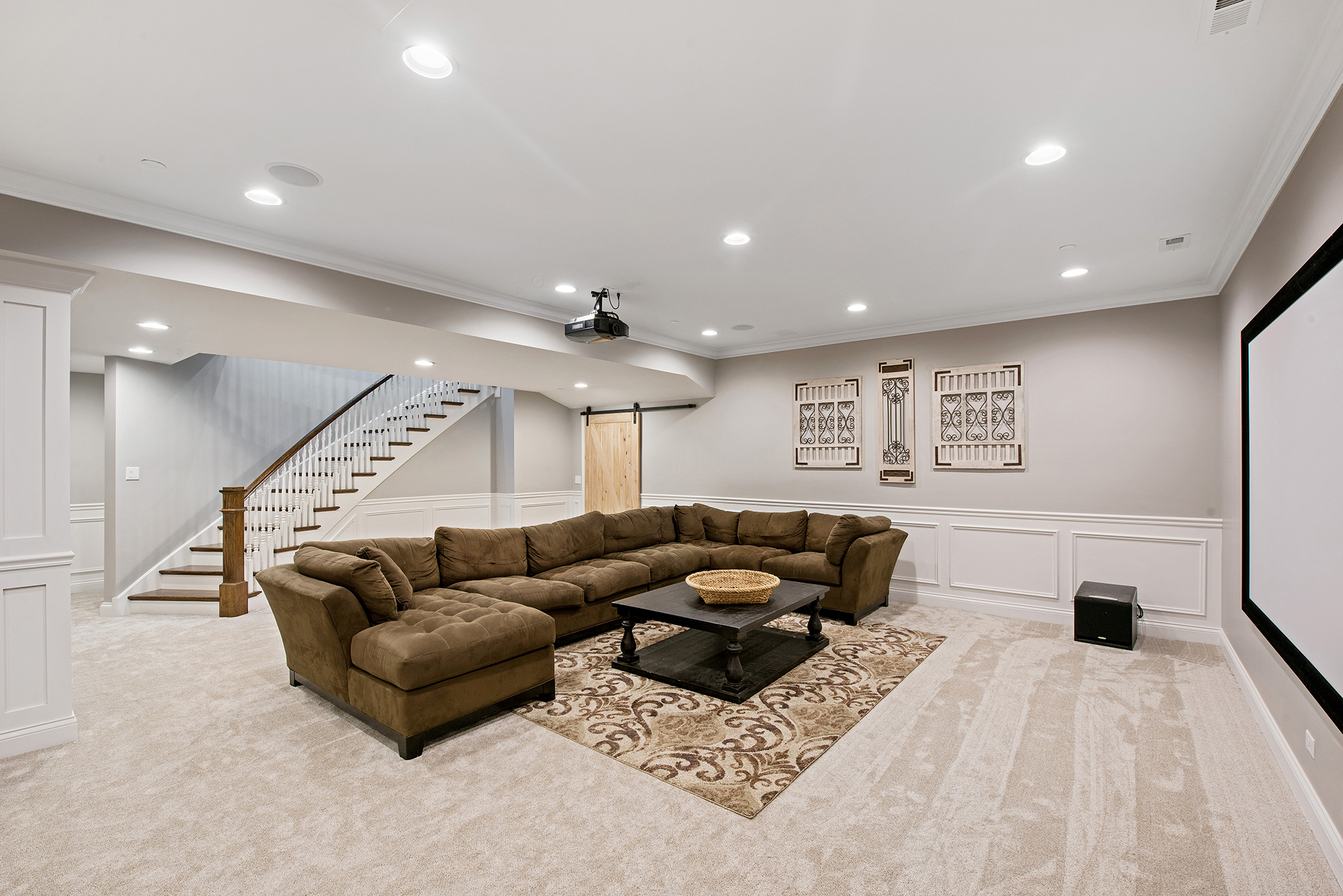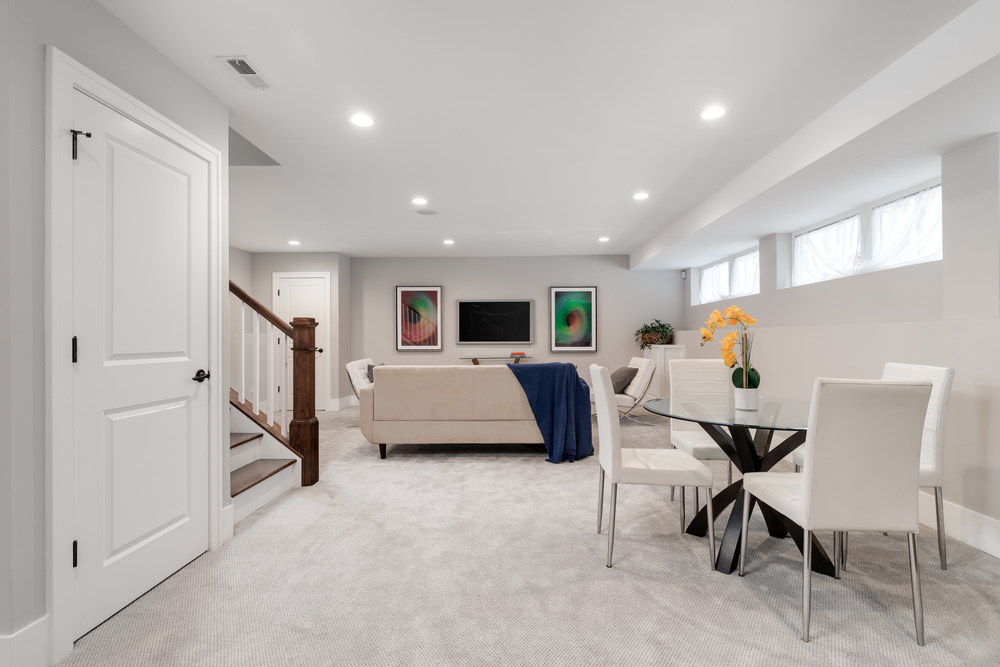Updating your basement can be one of the most satisfying home improvement projects. Whether you’re creating a cozy living space, a modern office, a workout zone, or a fun entertainment area, choosing the right paint color is essential. Because basements often lack natural light, have lower ceilings, and feature exposed materials, the color palette plays a crucial role in setting the tone, mood, and functionality of the space.
In this guide, we’ll walk you through everything you need to know about choosing the perfect basement paint color, along with pro tips and ideas to inspire your next basement makeover.
Why Paint Matters in a Basement
Unlike above-ground spaces, basements come with their own set of design challenges:

- Low natural light
- Cool temperatures
- Exposed ductwork or concrete
- Potential moisture issues
A fresh coat of paint does more than add color—it can:
- Brighten up dim spaces
- Make rooms feel larger and more open
- Control visual warmth or coolness
- Enhance the functionality and aesthetics of the room
Read More: DRICORE SMARTWALL Panels | Finishing Basement Walls Made Easy
Key Factors to Consider When Choosing a Basement Paint Color
Before you pick a shade, think through these key elements:
1. Lighting
Since most basements lack windows or sunlight, you’ll rely on artificial lighting. Choose paint colors with a high Light Reflectance Value (LRV) to help bounce light around the room.
Read More: 7ft Basement Ceiling Lighting Fixture Ideas: Smart Solutions for Low Ceilings
2. Room Function
The purpose of the space should influence your color choice:
- Entertainment Room: Warm neutrals or bold accent walls
- Home Office: Soothing blues or muted greens
- Home Gym: Energetic tones like light orange or vibrant gray
- Guest Room: Calm, relaxing colors like lavender or taupe
Read More: Basement Lighting: Our Top 5 Fixes for Poor Lighting
3. Ceiling Height
Lower ceilings can make a space feel tight. Light colors on the ceiling and upper walls can visually “lift” the space.
Read More: Roughing In Lights in a Basement (and Integrating Existing Lights): A Complete DIY Guide
4. Wall Material
Concrete or masonry may require specialized masonry or waterproof paint. Drywall gives you more flexibility with standard interior latex paints.
Read More: Adding Lights to an Existing Circuit While Finishing the Basement: A Complete DIY Guide
Best Paint Finishes for Basements
When updating your basement, the finish is just as important as the color. Here’s a quick guide:
| Finish | Best For | Pros |
|---|---|---|
| Matte or Flat | Hides imperfections | Low reflection, modern look |
| Eggshell | Low-traffic walls | Slightly more washable than flat |
| Satin | Family/living spaces | Durable, soft sheen |
| Semi-gloss | Utility or laundry rooms | Highly washable, moisture-resistant |
Tip: Use semi-gloss or satin on trims, baseboards, and doors for a finished and clean look.
Read More: The Ultimate Basement Finishing DIY Guide
Top 10 Basement Paint Color Ideas
Here are some popular and practical color ideas perfect for basement updates:
1. Warm White
A creamy, warm white helps brighten dark corners while still offering a cozy feel.
- Great for small or multi-purpose basements.
- Popular Shade: Benjamin Moore “Swiss Coffee”
Read More: Avoiding DIY Basement Remodeling Nightmares
2. Soft Gray
Light gray is elegant, modern, and versatile. Pairs well with wood, concrete, and metal.
- Works with any décor theme.
- Popular Shade: Sherwin-Williams “Repose Gray”
Read More: 6 Basement Renovation Ideas to Transform Your Space
3. Greige (Gray + Beige)
The perfect neutral for warmth without going full beige.
- Complements both traditional and modern basements.
- Popular Shade: Behr “Perfect Taupe”
Read More: 10 Essential Tools for DIY Basement Finishing
4. Pale Blue
Adds a refreshing, open-air feeling—perfect for low-ceiling spaces.
- Helps create calm zones like bedrooms or meditation areas.
- Popular Shade: Farrow & Ball “Borrowed Light”
Read More: Everything You Need to Know About a Finished Basement
5. Slate Blue or Navy Accent Walls
Darker hues create a dramatic, cozy effect—ideal for a theater room or bar area.
- Use sparingly with light trims or white ceilings.
- Popular Shade: Benjamin Moore “Hale Navy”
Read More: DIY Home Gym: Basement Transformation Part 1
6. Earthy Sage Green
Connects the indoors with nature—especially good if your basement has outdoor access.
- Works great in home offices or wellness zones.
- Popular Shade: Sherwin-Williams “Evergreen Fog”
Read More: Creating a Home Gym by Renovating a Basement: The Complete Guide
7. Soft Taupe
A classic, welcoming color that feels warm without being overpowering.
- Great for family rooms or dens.
- Popular Shade: Valspar “Filtered Shade”
Read More: Adding a Basement Gym to Your Home: The Ultimate Guide
8. Charcoal Gray
Moody and sophisticated, ideal for masculine spaces or modern designs.
- Pair with white or light gray for contrast.
- Popular Shade: Sherwin-Williams “Iron Ore”
Read More: Creating a Home Gym in an Unfinished Basement Space
9. Light Yellow or Buttercream
Adds a cheerful warmth to cold, windowless basements.
- Best for playrooms, art studios, or hobby rooms.
- Popular Shade: Behr “Lemon Soufflé”
Read More: How to Make an Unfinished Basement Gym in Your Home
10. Blush or Dusty Rose
For an unconventional but trendy option that works well with wood and brass accents.
- Use in lounge areas or eclectic creative spaces.
- Popular Shade: Benjamin Moore “First Light”
Read More: Basement Home Gym Ideas for the Ultimate Workout Space
Paint Prep Tips for Basements

1. Check for Moisture
Use a moisture meter or tape plastic sheeting to test for dampness. If needed, use a concrete or waterproof primer before painting.
Read More: Basement Gym Guide: How to Build the Ultimate Home Fitness Space
2. Clean & Prime
Clean the walls thoroughly and use a stain-blocking primer to cover discoloration or mold residue.
Read More: Organized Basement Home Gym Ideas: Maximize Your Space and Motivation
3. Seal Cracks
If painting concrete, fill all cracks and holes with masonry filler before priming.
Read More: 75 Small Laminate Floor Basement Ideas You’ll Love
4. Use the Right Tools
Use a high-nap roller for textured concrete or masonry walls and quality brushes for trims.
Read More: Transform Your Basement with Laminate Flooring: A Stylish, Affordable Upgrade
Safety and Durability Tips
- Opt for Low-VOC or Zero-VOC paint: Safe for enclosed areas like basements.
- Use anti-microbial additives: Especially in older or damp basements.
- Install dehumidifiers: This will keep your new paint job looking fresh longer.
Read More: The Basement: Installing the Laminate Floor – A Complete DIY Guide
Budgeting Your Basement Paint Update
| Task | Estimated DIY Cost | Professional Cost |
|---|---|---|
| Paint (2 gallons) | $60–$100 | Included in service |
| Primer | $20–$40 | Included |
| Supplies (rollers, tape, trays) | $30–$60 | Included |
| Labor | $0 | $1–$2/sq. ft. |
Tip: You can dramatically update your basement for under $300 if you DIY the job with quality products.
Read More: How to Choose Flooring for Your Basement Renovation: The Complete Guide
Final Thoughts
When it comes to basement updates, few things are as affordable and transformative as a new paint color. With the right shade, you can brighten a dim space, make low ceilings feel higher, and create a warm, welcoming atmosphere.
Whether you’re after timeless neutrals, soft pastels, or bold, dramatic tones, there’s a perfect color for every basement. Combine your choice with thoughtful lighting, durable flooring, and smart storage, and you’ll have a basement that feels like a true extension of your home—not just a forgotten space below ground.
